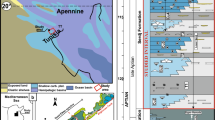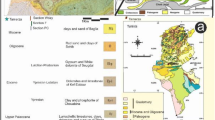Abstract
The demise of the rudist-bearing carbonate blatforms at the Cenomanian/Turonian boundary is tudied in different ways through examples from the Vestern Mediterranean Province. During the Late Cenonanian, North and South Tethyan carbonate platforms xtened widely and were subjected to different climatic and oceanographic conditions. The onset of the demise of the carbonate platforms occurred during Upper Arphaeocretacea and Helvetica biozone times and was boeval with the Global Oceanic Anoxic Event (OAE2). A major biologic turnover affected the benthic organisms i.e. rudists and large foraminifera. The rudists underwent a severe extinction event, leading to the disappearance of the dominantly aragonite secreting rudists, while the dominantly calcitic forms were less affected. The major development of the carbonate platforms occurred during the Latest Cenomanian — Earliest Turonian, involving a transgressive highstand system tract and a keep-up carbonate organization. During the Early Turonian the carbonate sedimentation was disturbed; hard-grounds, condensed beds, terrigenous inputs developed and a gap in the carbonate platform deposition occurred. A combination of several sequentially linked factors, could explain the demise of the carbonate platform and the major change on the benthic ecosystem at the Cenomanian-Turonian boundary.
Similar content being viewed by others
References
Abdallah H (1989) Les transgressions du Crétacé moyen entre les jeux tectoniques et les montées eustatiques (Sud Tunisien). In: Cotillon P (ed) Les événements de la partie moyenne du Crétacé (Aptien à Turonien), vol 11. Géobios, Lyon, pp 83–94
Arthur MA, Schlanger SO, Jenkins HC (1987) The cenomanian-Turonian oceanic anoxic event, II. Palaeoceanographic controls on organic matter production and preservation. In: Brooks J, Fleet A (eds) Marine petroleum source rocks. Spec Pub Geol Soc 26:401–420
Arthur MA, Dean WE, Pratt LM (1988) Geochemical and climatic effects of increased marine organic carbon burial at the Cenomanian/Turoniam boundary. Nature 335:714–717
Barron EJ, Washington WM (1982) Cretaceous climate: a comparison of atmospheric simulations with the geologic record. Palaeogeogr Palaeoclimatol Palaeoecol 40:103–133
Berthou PY (1984) Albian-Turonian stage boundaries and subdivisions in the Western Portuguese Basin, with special emphasis on the Cenomanian-Turonian boundary in the ammonite facies and rudist facies. Bull Geol Soc Denmark 33:41–55
Bilotte M (1978) Proposition pour une biozonation des séries épicontinentales du Cénomanien des Pyrénées. Geol Méditerranéenne 1:39–46
Borgomano J (1987) La plate-forme et le talus carbonatés du Crétacé supérieur du Gargano et des Murges (italie Méridionale). Stratigraphie, Sédimentologie, Diagenèse, Fonctionnement tectono sédimentaire. Thèse Univ Marseille 625 p
Brass GW, Southam JR, Peterson WH (1982) Warm saline bottom water in the ancient ocean. Nature 296:620–623
Brumsack HJ, Thurow J (1986) The geochemical facies of black shales from the Cenomanian/Turonian boundary event (CTBE). In: Degens ET, Meyers PA, Brassel SC (eds) Biogeochemistry of black shales. Mitt Geol Paläontol Inst Hamburg 60:247–265
Busson G (1972) Principes, méthodes et résultats d'une étude stratigraphique du Mésozoíque saharien, Mém Mus Hist Nat Paris 26:441
Busson G (1984) La sédimentation épicontinentale des bassins salins accomplis et des bassins evaporitiques avortés: effet sur la sédimentation océanique contemporaine et contigüe dans le cas du Crétacé saharien et nord atlantique. CR Acad Sci Paris 299,II, 5:213–216
Carter JG (1980) Environmental and biological controls of bivalve shell mineralogy and microstructure p. In: Rhoads DC, Lutz RA (eds) Skeletal growth of aquatic organisms. Plenum, New York
D'Argenio B, Horvath F, Channell JET (1980) Palaeotectonic evolution of Adria, the African promontory. Mém BRGM 115. Colloque 5, 26è CGI: 331–351
De Castro P (1980) Le alveoline aptiano-cenomaniane del Mediterranea centrale e orientale: sintesi problemi. In: Avvenimenti del Cretacico medio (Napoli, 2–29 febbraio 1980). Università degli Studi di Napoli, Instituto di Paleontologia, 3–86
Elder WP (1987) The paleoecology of the Cenomanian-Turonian (Cretaceous) stage boundary extinctions at Black Mesa, Arizona Palaios 2:24–40
Ferrandini M, Philip J, Babinot JF, Ferrandini J, Tronchetti G (1985) La plate-forme carbonatée du Cénomano-Turonien de la région d'Erfound-Errachidia (Sud-Est Marocain): stratigraphie et paléoenvironnents. Bull Soc Géol Fr (8) I 4:559–564
Floquet M, Philip J, Babinot JF, Tronchetti G, Bilotte M (1987) Transgressions-régression marines et événements biosédimentaires sur les marges pyrénéo-provençales et nord ibériques au Crétacé supérieur. Mém Géol Univ Dijon Fr Mém 11:245–258
Gimenez R (1989) La mégaséquence transgressive-régressive du Cénomanien supérieur dans la région méridionale de la Chaîne Ibérique (provinces de Valence et d'Albacete, Espagne). In: Cotillon P (ed) Les événements de la partie moyenne du Crétacé (Aptien à Turonien), vol 11. Géobios, Lyon, pp 59–67
Graciansky (de) PC, Brosse E, Derro G, Herbin JP, Montadert L, Müller C, Sigal J, Schaaf A (1987) Organic-rich sediments and palaeoenvironmental reconstructions, of the Cretaceous North Atlantic. In: Brooks J, Fleet A (eds) Marine petroleum source rocks. Spec Publ Geol Soc 26:317–344
Hallock P, Schlager W (1986) Nutrient excess and the demise of coral reefs and carbonate platforms. Palaios 1:389–398
Haq BU, Hardenbol J, Vail PR (1987) Chronology of fluctuating sea levels since the Triassic. Science 235:1156–1166
Hilbrecht H, Arthur MA, Schlanger SO (1986) The Cenomanian-Turonian boundary event: sedimentary, faunal and geochemical criteria developed from stratigraphic studies in NW-Germany. In: Walliser O (ed) Global bio-events. (Lecture Notes in Earth Science, vol 8, pp 345–370)
Jarvis I, Carson GA, Cooper MKE, Hart MB, Leary PN, Tocher BA, Horne D, Rosenfeld A (1988a) Microfossil assemblages and the Cenomanian-Turonian (late Cretaceous) oceanic anoxic event. Cretaceous Res 9:3–103
Jarvis I, Carson G, Hart M, Leary PN, Tocher B (1988b) The Cenomanian_Turonian (late Cretaceous) anoxic event in SW England: evidence from Hooken Cliffs near Beer, SE Devon. Newsl Stratigr 18, 3:147–164
Kauffman EG (1984) The fabric of Cretaceous marine extinctions. In: Berggren WA, Van Couvering J (eds) Catastrophes and earth history. The new uniformitarianism. Princeton University Press, pp 151–246
Kauffman EG (1986) High resolution event stratigraphy: regional and global Cretaceous bio-events. In: Walliser O (ed) Global bio-events. (Lecture notes in earth sciences, vol 8, pp 279–335)
Kemper E (1987) Das Klima der Kreide-Zeit. Geol Jahrb A 96:5–187
Kennedy WJ (1984) Ammonite faunas and the “standard zones” of the Cenomanian to Maastrichtian Stages in their type areas, with some proposals for the definition of the stage boundaries by ammonites, Bull Geol Soc Denmark 33:147–161
Kuhn O (1932) Rudistae. Fossilium catalogus I. Animalia Editus a W Quenstedt Pars 54, Berlin, 200 p
Kuhnt W, Thurow J, Wiedmann J, Herbin JP (1986) Oceanic anoxic conditions around the Cenomanian/Turonian boundary and the response of the biota. In: Degens ET, Meyers PA, Brassel SC (eds) Biogeochemistry of black shales. Mitt Geol Paläontol Inst Hamburg 60:205–246
Kutassy A (1934) Pachyodonta mesozoica. Fossilium catalogus I: Animalia. Editus a W Quenstedt Pars 68, Berlin, 202 p
Lloyd CR (1982) The Mid-Cretaceous earth: paleogeography, ocean circulation and temperature; atmospheric circulation. J Geol 90:393–413
Macellari CE, Vries TJ de (1987) Late Cretaceous upwelling and anoxic sedimentation in Northwestern South America. Palaeogeogr Palaeoclimatol Palaeoecol 59:279–292
McKinney ML, Oyen CW (1989) Causation and nonrandomness in biological and geological time series: temperature as a proximal control of extinction and diversity. Palaios 4:3–15
Masse JP, Phillip J (1986) L'evolution des Rudistes au regard des principaux événements géologiques du Crétacé. Bull Centres Rech Explor-Prod Elf-Aquitaine, 10, 2:437–456
Parrish JT, Ziegler AM, Scotese CR (1982) Rainfall patterns and the distribution of coals and evaporite in the Mesozoic and Cenozoic. Palaeogeogr Palaeoclimatol Palaeoecol 40:67–101
Philip J (1978) Stratigraphie et paléoécologie des formations à rudistes du Cénomanien: l'exemple de la Provence. In: Coll Cénom Français (Paris, 1976). Rev Geol Medit 5, 1:155–168
Philip J (1982) Paléobiogéographie des rudistes et géodynamiques des marges mésogéennes au Crétacé supérieur. Bull Soc Géol Fr (7), XXXIV 5–6:995–1006
Philip J, Airaud C, Tronchetti G (1989a) Evénements paléogéographiques en Provence (SE France) au passage Cénomanien-Turonien. Modifications biosédimentaires. Causes géodynamiques. In: Cotillon P (ed), Les événements de la partie moyenne du Crétacé (Aptien à Turnien), vol 11. Geobios, Lyon, pp 107–117
Philip J, Mermighis A, Tronchetti G (1989b) Nouvelles données stratigraphiques et paléogéographiques sur le Crétacé supérieur du domaine hellénique interne. Le massif de l'Akros (Argolide, Grèce). CR Acad Sci Paris sér II:1379–1384
Polsak A, Bauer V, Sliskovic T (1982) Stratigraphie du Crétacé supérieur de la plate-forme carbonatée dans les Dinarides externes. Cretaceous Res 3:125–133
Pratt LM (1985) Isotopic studies of organic matter and carbonate in rocks of the Greenhorn marine cycle in Fine-Grained deposits and biofacies of the Cretaceous Western Interior Seaway: evidence of cyclic sedimentary processes. Partt LM, Kauffman EG, Zelt FB (eds) Soc Econ Pal Mineral, Field Trip Guide Book 4:38–48
Reyment RA (1980) Biogeography of the Saharan Cretaceous and Paleocene Epicontinental transgressions. Cretaceous Res 1, 4:299–328
Sarg JF (1988) Carbonate sequence stratigraphy. SEPM Spec Publ 42:155–182
Sanchez V. (1981) Hippuritidae y Radiolitidae. Catalogo de especies. Publ Geol Univ Auton Barcelona 15:228 p
Schlager W (1981) The paradox of drowned reefs and carbonate platforms. Geol Soc Am Bull 92:197–211
Schlanger SO, Arthur MA, Jenkyns HC, Scholle PA (1987) The Cenomanian-Turonian oceanic anoxic event. I. Stratigraphy and distribution of organic carbon-rich beds and the marine13 C excursion. In: Brooks J, Fleet A (eds) Marine petroleum source rocks. Spec Publ Geol Soc 26:371–399
Schroeder R, Neumann M (eds) (1985) Les Grands Foraminifères du Crétacé moyen de la région méditerranéenne. Géobios, Lyon, 7:160p
Scott R.W. (1988) Evolution of Late Jurassic and Early Cretaceous reef biotas. Palaios 3:184–193
Thurow J, Kuhnt W, Wiedmann J (1982) Zeitlicher und paläogeographischer Rahmen der Phthanit und Black Shale-Sedimentation in Marokko. NJb Geol Paläontol Abh 165:147–176
Author information
Authors and Affiliations
Rights and permissions
About this article
Cite this article
Philip, J.M., Airaud-Crumiere, C. The demise of the rudist-bearing carbonate platforms at the Cenomanian/Turonian boundary: a global control. Coral Reefs 10, 115–125 (1991). https://doi.org/10.1007/BF00571829
Accepted:
Issue Date:
DOI: https://doi.org/10.1007/BF00571829




